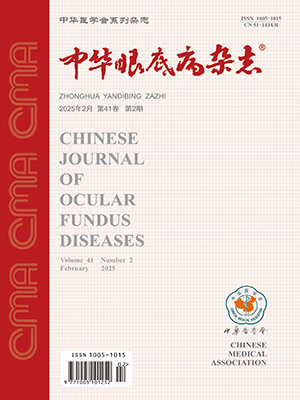| 1. |
Mihalich A, Cammarata G, Tremolada G, et al. Two novel CACNA1F gene mutations cause two different phenotypes: Aland eye disease and incomplete congenital stationary night blindness[J/OL]. Exp Eye Res, 2022, 221: 109143[2022-06-11]. https://doi.org/10.1016/j.exer.2022.109143. DOI: 10.1016/j.exer.2022.109143.
|
| 2. |
Kim HM, Joo K, Han J, et al. Clinical and genetic characteristics of Korean congenital stationary night blindness patients[J]. Genes (Basel), 2021, 12(6): 789-803. DOI: 10.3390/genes12060789.
|
| 3. |
Heigl T, Netzer MA, Zanetti L, et al. Characterization of two pathological gating-charge substitutions in Cav1.4 L-type calcium channels[J/OL]. Channels (Austin), 2023, 17(1): 2192360[2023-12-01]. https://pubmed.ncbi.nlm.nih.gov/36943941/. DOI: 10.1080/19336950.2023.2192360.
|
| 4. |
Mahmood U, Méjécase C, Ali SMA, et al. A novel splice-site variant in CACNA1F causes a phenotype synonymous with Aland island eye disease and incomplete congenital stationary night blindness[J]. Genes (Basel), 2021, 12(2): 171-179. DOI: 10.3390/genes12020171.
|
| 5. |
Jalkanen R, Mäntyjärvi M, Tobias R, et al. X linked cone-rod dystrophy, CORDX3, is caused by a mutation in the CACNA1F gene[J]. J Med Genet, 2006, 43: 699-704. DOI: 10.1136/jmg.2006.040741.
|
| 6. |
Boycott KM, Pearce WG, Bech-Hansen NT. Clinical variability among patients with incomplete X-linked congenital stationary night blindness and a founder mutation in CACNA1F[J]. Can J Ophthalmol, 2000, 35(4): 204-213. DOI: 10.1016/s0008-4182(00)80031-9.
|
| 7. |
Thomas MG, Kumar A, Mohammad S, et al. Structural grading of foveal hypoplasia using spectral-domain optical coherence tomography a predictor of visual acuity?[J]. Ophthalmology, 2011, 118(8): 1653-1660. DOI: 10.1016/j.ophtha.2011.01.028.
|
| 8. |
Hertle RW. Nystagmus in infancy and childhood: characteristics and evidence for treatment[J]. Am Orthopt J, 2010, 60: 48-58. DOI: 10.3368/aoj.60.1.48.
|
| 9. |
Vincent A, Wright T, Day MA, et al. A novel p. Gly603Arg mutation in CACNA1F causes Åland island eye disease and incomplete congenital stationary night blindness phenotypes in a family[J]. Mol Vis, 2011, 17: 3262-3270.
|
| 10. |
Specht D, Wu SB, Turner P, et al. Effects of presynaptic mutations on apost synaptic Cacna1s calcium channel colocalized with mGluR6 at mouse photoreceptor ribbon synapses[J]. Invest Ophthalmol Visual Sci, 2009, 50(2): 505-515. DOI: 10.1167/iovs.08-2758.
|
| 11. |
Morgans CW. Localization of the alpha(1F) calcium channel subunit in the rat retina[J]. Invest Ophthalmol Vis Sci, 2001, 42(10): 2414-2418.
|
| 12. |
Davison A, Lux UT, Brandstätter JH, et al. T-type Ca2+ channels boos neurotrans-mission in mammalian cone photoreceptors[J]. J Neurosci, 2022, 42(33): 6325-6343. DOI: 10.1523/JNEUROSCI.1878-21.2022.
|
| 13. |
Zabouri N, Haverkamp S. Calcium channel-dependent molecular maturation of photoreceptor synapses[J/OL]. PLoS One, 2013, 8(5): e63853[2013-05-13]. https://pubmed.ncbi.nlm.nih.gov/23675510/. DOI: 10.1371/journal.pone.0063853.
|
| 14. |
Mansergh F, Orton NC, Vessey JP, et al. Mutation of the calcium channel gene Cacna1f disrupts calcium signaling, synaptic transmission and cellular organization in mouse retina[J]. Hum Mol Genet, 2005, 14(20): 3035-3046. DOI: 10.1093/hmg/ddi336.
|
| 15. |
Leahy KE, Wright T, Grudzinska Pechhacker MK, et al. Optic atrophy and inner retinal thinning in CACNA1F-related congenital stationary night blindness[J]. Genes (Basel), 2021, 12(3): 330-337. DOI: 10.3390/genes12030330.
|
| 16. |
Chang B, Heckenlively JR, Bayley PR, et al. The nob2 mouse, a null mutationin Cacna1f: anatomical and functional abnormalities in the outer retina and their consequences on ganglion cell visual responses[J]. Vis Neurosci, 2006, 23(1): 11-24. DOI: 10.1017/S095252380623102X.
|
| 17. |
Laird JG, Kopel A, Lankford CK, et al. Mouse all-cone retina models of Cav1.4 synaptopathy[J/OL]. Front Mol Neurosci, 2023, 16: 1155955[2023-04-27]. https://pubmed.ncbi.nlm.nih.gov/37181655/. DOI: 10.3389/fnmol.2023.1155955.
|
| 18. |
Bijveld MM, Kappers AM, Riemslag FC, et al. An extended 15 Hz ERG protocol: the contributions of primary and secondary rod pathways and the cone pathway[J]. Doc Ophthalmol, 2011, 123(3): 149-159. DOI: 10.1007/s10633-011-9292-z.
|
| 19. |
Williams B, Lopez JA, Maddox JW, et al. Functional impact of a congenital stationary night blindness type 2 mutation depends on subunit composition of Cav1.4 Ca2+ channels[J]. J Biol Chem, 2020, 295(50): 17215-17226. DOI: 10.1074/jbc.RA120.014138.
|
| 20. |
Leigh RJ. Smooth pursuit and visual fixation[M]//Leigh RJ, Zee DS. The neurology of eye movements. 4th ed. New York: Oxford University Press, 2006: 216-217.
|
| 21. |
Simonsz HJ, Florijn RJ, van Minderhout HM, et al. Nightblindness-associated transient tonic downgaze (NATTD) in infant boys with chin-up head posture[J]. Strabismus, 2009, 17(4): 158-164. DOI: 10.3109/09273970903396893.
|
| 22. |
Winkelman BHJ, Howlett MHC, Hölzel MB, et al. Nystagmus in patients with congenital stationary night blindness (CSNB2A) originates from synchronous-ly firing retinal ganglion cells[J/OL]. PLoS Biol, 2019, 17(9): e3000174[2019-09-12]. https://pubmed.ncbi.nlm.nih.gov/31513577/. DOI: 10.1371/journal.pbio.3000174.
|
| 23. |
Brodsky MC, Dell’Osso LF. A unifying neurologic mechanism for infantile nystagmus[J]. JAMA Ophthalmol, 2014, 132(6): 761-768. DOI: 10.1001/jamaophthalmol.2013.5833.
|
| 24. |
Wang P, Ya P, Li D, et al. Nystagmus with pendular low amplitude, high frequency components (PLAHF) in association with retinal diseases[J]. Strabismus, 2020, 28(1): 3-6. DOI: 10.1080/09273972.2019.1707237.
|




